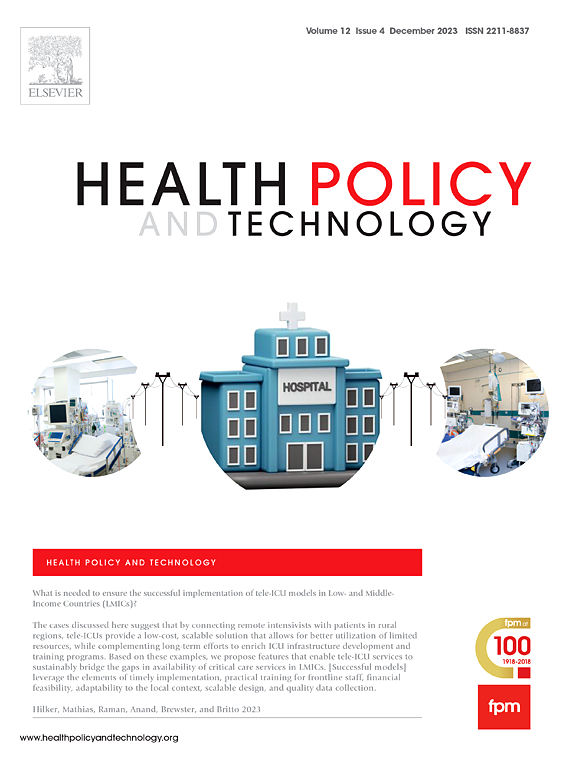Health equity in the digital age: Exploring health policy and inclusive digital care
IF 3.7
3区 医学
Q1 HEALTH POLICY & SERVICES
引用次数: 0
Abstract
Objectives
The digitalisation of care, whilst beneficial for some, also risks exacerbating health inequities if existing health (and social) disparities are not considered. Literature has indicated the broad, systemic causes of digital health inequities could be addressed through policy. This article aims to explore how health inequities are rendered (in)visible in and by digital care policies.
Methods
We inductively analysed sixteen Dutch health policy documents focusing on digital care. Employing a constructivist grounded theory approach, we analysed documents to determine how health equity is addressed in relation to digital care.
Results
Although Dutch health policies do consider health inequities, it is not always shown in policies as a concept related to digital care. Health policies portray digital care as progressive and innovative, being able to shape healthcare in several positive ways. The risks of digital care are attended to less, with focus being placed mostly on privacy and data-security rather than also paying attention to digital health inequities.
Conclusions
Policies either ignore digital health equity entirely or present digital health equity in ways that risk overlooking how digital care may subtly aggravate health inequities. This creates a blind spot in which technological deterministic narratives can be disguised. Current policies could unintentionally perpetuate exclusion by not highlighting the role of digital health inequities as a part of the health equity landscape. Policy needs to allow for digital health inequities to be better recognised, allowing digital care to drive, rather than limit, the possibilities for a more equitable future.
Lay Summary
Digital care is increasing in popularity, but risks excluding a significant number of people who usually already experience health inequities. Although Dutch health policy does consider health inequities, it is not shown in policies as a concept related to digital care. As a result, health equity risks being forgotten in the development of digital care. Policies portray digital care as being able to shape healthcare in a number of positive ways but do not address the risks it may pose in widening health inequities. Instead, issues like ensuring privacy receive more attention. By being overly optimistic about technology without being cautious about its other social consequences, achieving aims such as affordable and accessible care could be negatively impacted. Policy needs to allow for digital health inequities to be better recognised, allowing digital care to drive, rather than limit, the possibilities for a more equitable future.
数字时代的卫生公平:探索卫生政策和包容性数字护理
医疗数字化虽然对一些人有益,但如果不考虑现有的健康(和社会)差距,也有加剧卫生不平等的风险。文献表明,数字卫生不平等的广泛、系统性原因可以通过政策来解决。本文旨在探讨卫生不平等是如何在数字医疗政策中显现出来的。方法对荷兰16份以数字医疗为重点的卫生政策文件进行归纳分析。采用建构主义扎根理论方法,我们分析了文献,以确定如何解决与数字医疗相关的卫生公平问题。结果虽然荷兰的卫生政策确实考虑到卫生不平等,但它并不总是作为与数字保健相关的概念显示在政策中。卫生政策将数字医疗描绘为进步和创新,能够以多种积极的方式塑造医疗保健。对数字医疗风险的关注较少,重点主要放在隐私和数据安全上,而不是关注数字医疗不平等问题。政策要么完全忽视数字健康公平,要么以忽视数字医疗如何微妙地加剧健康不平等的方式呈现数字健康公平。这就造成了一个盲点,在这个盲点中,技术决定论的叙述可以被伪装起来。目前的政策没有强调数字卫生不平等作为卫生公平格局一部分的作用,可能会无意中使排斥现象永久化。政策需要允许更好地认识到数字卫生不公平现象,使数字保健能够推动而不是限制实现更公平未来的可能性。数字医疗越来越受欢迎,但有可能将大量通常已经经历健康不平等的人排除在外。虽然荷兰的卫生政策确实考虑到卫生不公平现象,但在政策中并未将其作为与数字保健相关的概念加以体现。因此,在数字医疗的发展过程中,卫生公平有可能被遗忘。政策将数字医疗描述为能够以多种积极的方式塑造医疗保健,但没有解决它可能导致卫生不平等现象扩大的风险。相反,像确保隐私这样的问题得到了更多的关注。对技术过于乐观,而对其其他社会后果不谨慎,可能会对实现可负担和可获得的医疗服务等目标产生负面影响。政策需要允许更好地认识到数字卫生不公平现象,使数字保健能够推动而不是限制实现更公平未来的可能性。
本文章由计算机程序翻译,如有差异,请以英文原文为准。
求助全文
约1分钟内获得全文
求助全文
来源期刊

Health Policy and Technology
Medicine-Health Policy
CiteScore
9.20
自引率
3.30%
发文量
78
审稿时长
88 days
期刊介绍:
Health Policy and Technology (HPT), is the official journal of the Fellowship of Postgraduate Medicine (FPM), a cross-disciplinary journal, which focuses on past, present and future health policy and the role of technology in clinical and non-clinical national and international health environments.
HPT provides a further excellent way for the FPM to continue to make important national and international contributions to development of policy and practice within medicine and related disciplines. The aim of HPT is to publish relevant, timely and accessible articles and commentaries to support policy-makers, health professionals, health technology providers, patient groups and academia interested in health policy and technology.
Topics covered by HPT will include:
- Health technology, including drug discovery, diagnostics, medicines, devices, therapeutic delivery and eHealth systems
- Cross-national comparisons on health policy using evidence-based approaches
- National studies on health policy to determine the outcomes of technology-driven initiatives
- Cross-border eHealth including health tourism
- The digital divide in mobility, access and affordability of healthcare
- Health technology assessment (HTA) methods and tools for evaluating the effectiveness of clinical and non-clinical health technologies
- Health and eHealth indicators and benchmarks (measure/metrics) for understanding the adoption and diffusion of health technologies
- Health and eHealth models and frameworks to support policy-makers and other stakeholders in decision-making
- Stakeholder engagement with health technologies (clinical and patient/citizen buy-in)
- Regulation and health economics
 求助内容:
求助内容: 应助结果提醒方式:
应助结果提醒方式:


